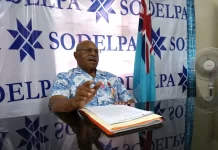By Ronald Toito’ona
A recent illegal, unreported, and unregulated (IUU) fishing report released last December revealed that Pacific licensed vessels or fleets are heavily involved in IUU fishing in the region through the misreporting of tuna catch.
The Quantification of Illegal, Unreported and Unregulated (IUU) Fishing in the Pacific Islands Region Report 2020 also concluded that IUU fishing in the Pacific is dominated by misreporting.
The report highlighted that much of the misreporting is coming from the purse-seine fishing sector, which contributed 89 percent of the estimated IUU catch by volume from 2017-19.
“Most of this misreporting was in the purse-seine fishing sector, where there is 100% observer coverage providing good independent estimates of catch. However, it can be challenging to identify species and estimate catch at sea due to the scale of the catches,” the report stated.
The report further states that around US$152m of misreported IUU catch volume was accounted for by the purse-seine fishing sector.
“…. However, with 100% observer coverage for this fishery, any errors in catch reports can be picked up. In addition, purse-seine vessels are licensed to access the fishery through the Vessel Day Scheme, meaning direct revenue loss associated with misreporting is likely to be negligible,” the report stated.
While there is less IUU fishing estimated in longline fisheries, their target tuna catch of bigeye and Southern albacore tuna is more valuable; longline IUU fishing is worth more than half of the total estimated IUU fishing by dollar value (about US$181m).
The report, which was compiled from a second study after the first in 2016, also highlighted that only 5% of the overall estimated IUU catch was thought to be from various forms of unlicensed fishing.
It also highlighted that few unlicensed fishing vessels were detected or prosecuted during the study period, except for incursions by illegal boats on the western fringe of the Pacific Islands Forum Fisheries Agency (FFA) area.
“Non-compliance with licence conditions and post-harvest regulations were each estimated to account for another 3% of IUU,” it stated.
Despite the challenges faced by the Pacific region in tackling IUU fishing, Pacific cooperation which is being spearheaded by regional fisheries agencies – such as FFA and its partners and stakeholders – can help in addressing these challenges. This regional cooperation and use of monitoring, control, and surveillance (MCS) tools which are available, keep the level of IUU fishing in the region as low as possible.
The report had stated that while IUU fishing in its various guises will require ongoing attention from FFA members, there is little doubt that the MCS measures which FFA members and their partners and regional secretariats have implemented over recent decades have had a profound impact on both the nature and volume of IUU fishing in the region.
It highlighted that “cooperative regional MCS measures such as:
*the establishment of the FFA Vessel Register and Good Standing requirement
*the agreement of Harmonised Minimum Terms and Conditions (HMTCs) for foreign fishing vessel access
*the establishment of the FFA Vessel Monitoring System (VMS), the development of common regional data collection protocols and forms
*the establishment of regional Pacific Island Regional Fisheries Observer (PIRFO) standards and training for observers
*the Niue Treaty and Subsidiary Arrangement to facilitate cooperation on MCS including information sharing and coordinated regional operations, amongst others, have substantially strengthened the MCS environment across all member zones compared to individual members acting alone.”
The relatively low estimates of IUU activity in the FFA region – compared to many other parts of the world – is practical evidence of the MCS framework’s success, stated the report.
SOURCE: TUNA PACIFIC/PACNEWS














